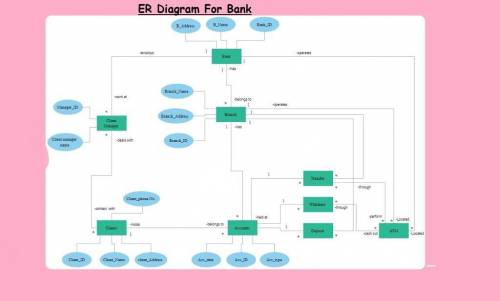
Computers and Technology, 06.03.2020 23:33 jamaicalove2880
Draw an ER diagram using the IDEF1X Notation and ERWIN for the following application. If you discover that the following narrative is incomplete, make up reasonable explanations to complete the description. State clearly your assumptions.
Your assumptions should not contradict the assumptions stated in the narrative.1.The software maintains and manages information related to employees, rooms, committees, and committee meetings of a company. The information include at least the following data:Employee: IDNumber, Full Name, Office Location, Telephone Number, Department, and Position. Employee’s Schedule: Date, Start Time, End Time, and Task .Room: Building Number, Room Number, and Capacity. Room Schedule: Date, Start Time, End Time, and Status. Committee: Title, Chair’s Name , Chair’sIDNumber, and Members. Committee Meeting: Meeting Number, Date, Start Time, and End Time.

Answers: 3


Another question on Computers and Technology

Computers and Technology, 22.06.2019 06:30
Plz 40 points what are raster vectors? a bitmap image a vector file a type of printing press a small projector
Answers: 1

Computers and Technology, 23.06.2019 17:00
What are the 12 colors of the spectrum called?
Answers: 1

Computers and Technology, 23.06.2019 23:00
Lucas put a lot of thought into the design for his company's new white paper. he made sure to include repeating design elements such as color schemes and decorative images. his goal was to a.add symmetry b.create a unified publication c.provide consistency d.save money
Answers: 1

Computers and Technology, 24.06.2019 14:40
Create a function (prob3_6) that will do the following: input a positive scalar integer x. if x is odd, multiply it by 3 and add 1. if the given x is even, divide it by 2. repeat this rule on the new value until you get 1, if ever. your program will output how many operations it had to perform to get to 1 and the largest number along the way. for example, start with the number 3: because 3 is odd, we multiply by 3 and add 1 giving us 10. 10 is even so we divide it by 2, giving us 5. 5 is odd so we multiply by 3 and add one, giving us 16. we divide 16 (even) by two giving 8. we divide 8 (even) by two giving 4. we divide 4 (even) by two giving 2. we divide 2 (even) by 2 to give us 1. once we have one, we stop. this example took seven operations to get to one. the largest number we had along the way was 16. every value of n that anyone has ever checked eventually leads to 1, but it is an open mathematical problem (known as the collatz conjectureopens in new tab) whether every value of n eventually leads to 1. your program should include a while loop and an if-statement.
Answers: 3
You know the right answer?
Draw an ER diagram using the IDEF1X Notation and ERWIN for the following application. If you discove...
Questions

Advanced Placement (AP), 18.12.2020 19:50

Mathematics, 18.12.2020 19:50




Arts, 18.12.2020 19:50


History, 18.12.2020 19:50

Mathematics, 18.12.2020 19:50

Mathematics, 18.12.2020 19:50

History, 18.12.2020 19:50


Geography, 18.12.2020 19:50

Mathematics, 18.12.2020 19:50

Biology, 18.12.2020 19:50


Mathematics, 18.12.2020 19:50

Mathematics, 18.12.2020 19:50


Mathematics, 18.12.2020 19:50





